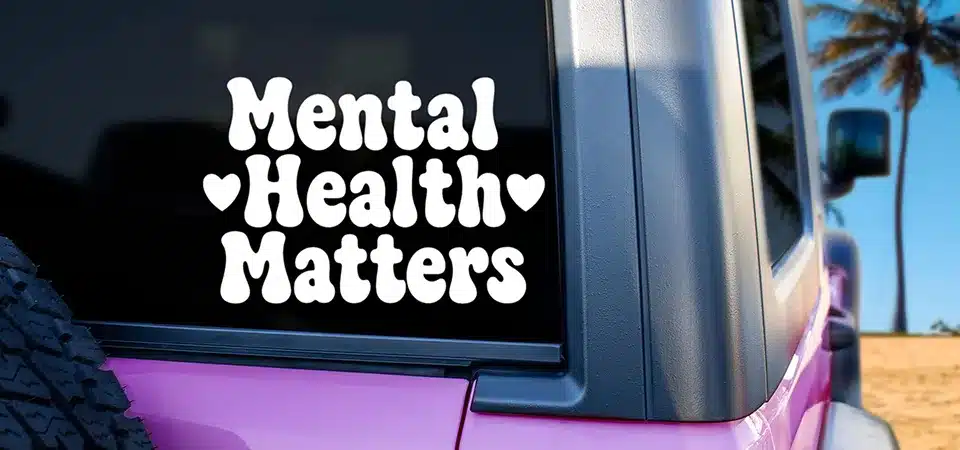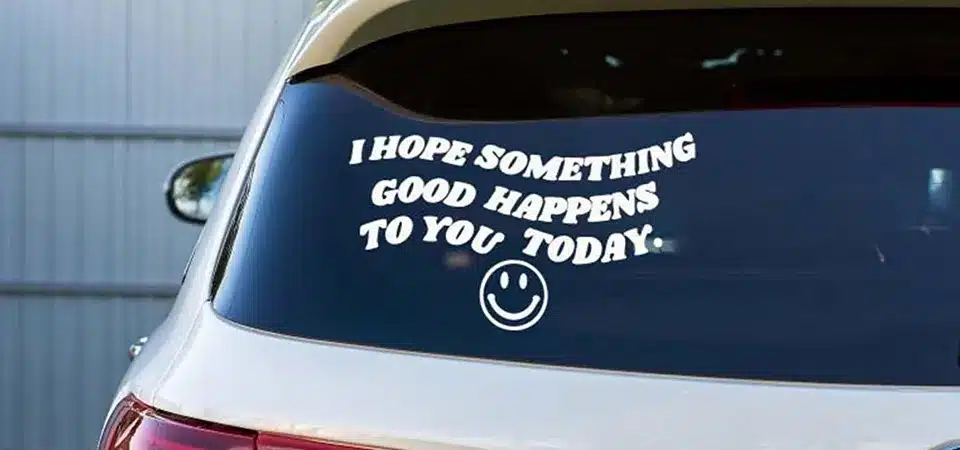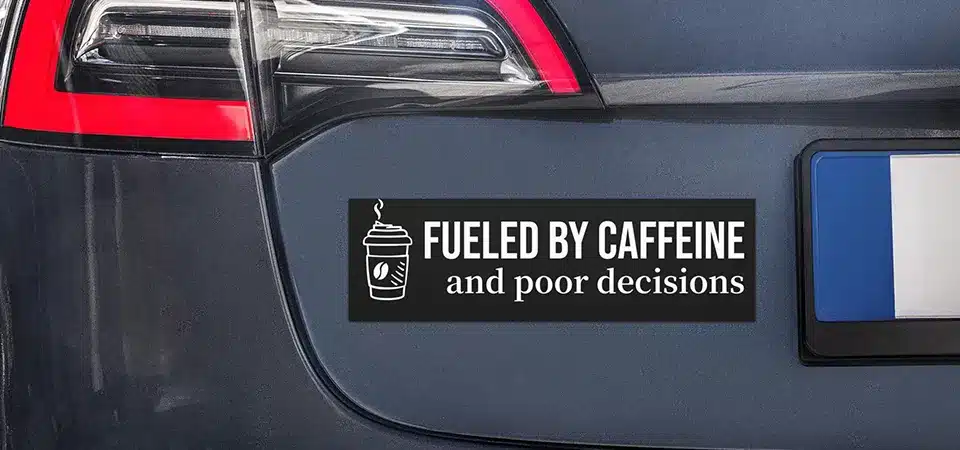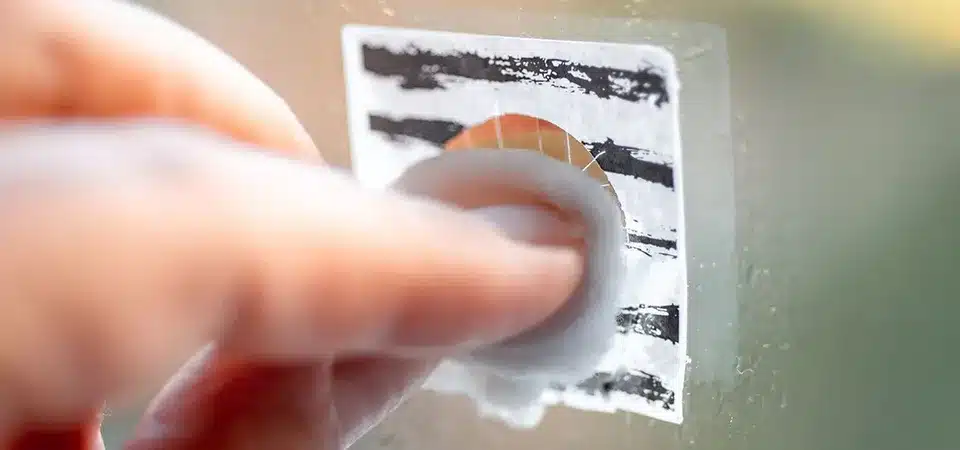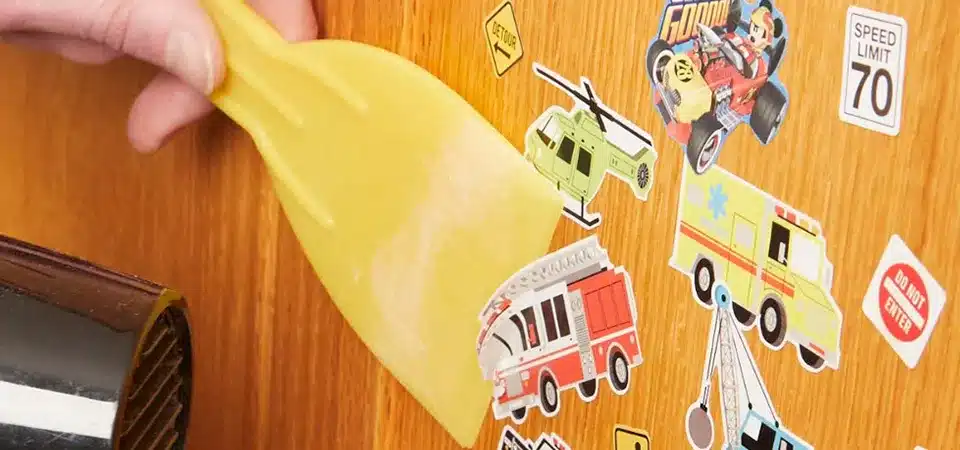You’ve invested in a great car sticker. But you fear it will fade, peel, and crack in just a few months, making your car look cheap and worn out.
High-quality car stickers can last from 3 to 7 years. Durability depends on the vinyl material, UV lamination, sun exposure, and proper application. Premium materials will always outlast cheaper, unlaminated options, which can fail within a year.
The difference between a sticker that lasts one year and one that lasts seven isn't magic. It comes down to what the sticker is made of and how you treat it. As someone who prints custom stickers every single day, I see the results of both good and bad choices. The great news is that you have a lot of control over the outcome. Let's dig into the details that really matter.
What are quality car stickers made from?
You see the term "vinyl sticker" everywhere, but it can be vague. You don't want to accidentally buy a cheap material that will quickly fade and fail on your vehicle.
Quality car stickers are made from durable, weatherproof vinyl (PVC) with a strong, permanent adhesive. For maximum life, they should be printed with UV-resistant inks and protected with a clear overlaminate that shields them from sun, scratches, and chemicals.
When a client asks me for a sticker that needs to withstand the outdoors, I know we have to talk about its construction. It’s like building a tiny, flexible shield for your car. There are three critical layers that work together to fight off the elements.
The Vinyl Base
The foundation of any good car sticker is the vinyl itself. This is a type of plastic called PVC. But not all vinyl is created equal. I generally work with two types: calendared and cast. Calendared vinyl is common and works well for simple, flat applications. For a car, especially on curved surfaces, I always recommend cast vinyl. It's a premium material that starts as a liquid and is cast into a sheet. This process means it has no "memory," so it won't shrink over time and pull away at the edges.
The Ink
The image on your sticker needs to fight the sun every single day. The sun's UV rays are the primary cause of fading. That's why we use specialty inks designed for outdoor durability, like eco-solvent or UV-cured inks. These inks are chemically resistant to fading, ensuring your design stays vibrant for years, not months.
The Overlaminate
This is the secret weapon. An overlaminate is a thin, clear layer of vinyl that we apply over the top of the printed sticker. It's like sunscreen for your sticker. It provides a powerful barrier against UV rays, but it also protects the print from physical damage like scratches, road grime, and mild chemicals like gasoline spills at the pump. When clients want a sticker to last 5-7 years, lamination is not optional; it's essential.
Will a car wash ruin my stickers?
Your car is dirty, but you're scared to take it through a car wash. Will those high-pressure jets and harsh brushes completely destroy your favorite sticker?
No, a standard car wash will not ruin a high-quality, properly applied vinyl sticker. However, you must wait 48-72 hours after application for the adhesive to fully cure. You should also avoid using high-pressure wands directly on the sticker's edges.
I get this question all the time. People are so careful with their new stickers, they're afraid to even wash them. But a professionally made sticker is tougher than you think. The key is to give it a good start in life and then use a little common sense.
Let the Adhesive Cure
The most critical period is the first two to three days after you apply the sticker. The adhesive needs this time to "cure," which means it's forming its strongest possible bond with your car's surface. During this time, the sticker is vulnerable. Washing the car too soon can force water under the edges and ruin the bond before it's fully set. Just be patient and leave it alone for a few days.
Automatic vs. Hand Washing
For the most part, modern automatic car washes are safe.
- Touchless Washes: These are the best option. They use high-pressure soap and water but no physical brushes, so there's nothing to snag the edge of your sticker.
- Soft-Touch/Brush Washes: These are usually safe too. The laminate on a quality sticker is designed to resist light scuffs and scratches. While an old, abrasive brush could cause wear over many years, it's generally not a concern.
- Hand Washing: This is the gentlest method. You have full control and can wash the sticker just like you wash the rest of your car.
The only real danger is the self-serve pressure washer. If you hold the nozzle an inch away and blast the edge of the sticker, you can force water underneath and cause it to lift. My simple rule is to keep the wand at least 12-18 inches away from the sticker and never spray directly at the edges.
What makes car stickers peel off?
You applied your new sticker, and it looked perfect. But after a few weeks, you notice a corner starting to lift. What went wrong, and how can you stop it from happening?
Car stickers peel almost exclusively due to improper surface preparation. Oil, wax, or fine dust on the car's surface prevents the adhesive from forming a strong bond. Other causes include cheap vinyl that shrinks or blasting the edges with a pressure washer.
When a customer tells me their sticker is peeling, the first question I ask is, "How did you clean the surface before you applied it?" Nine times out of ten, that's where the problem lies. The adhesive on a vinyl sticker is incredibly strong, but it can only stick to the car—not to a layer of dirt or wax on top of the car.
The #1 Enemy: A Dirty Surface
This is the single biggest cause of sticker failure. A surface that looks clean to the eye can still be covered in a thin layer of wax, road grime, or oil from your hands. The adhesive will stick to this layer, and then this weak layer will lift right off the car, taking your sticker with it. The professional method is a two-step process: first, wash the area with soap and water to remove dirt. Second, after it's dry, do a final wipe-down with isopropyl (rubbing) alcohol on a clean cloth. The alcohol removes any leftover wax or oils, leaving a perfectly clean surface for the adhesive to bond to.
Other Causes of Peeling
- Material Shrinkage: This is an issue with cheaper calendared vinyl. Over time, as it's heated by the sun and then cools, it can shrink a tiny amount. This shrinkage pulls the sticker inward, causing the edges to curl up and peel. This is why I always push for higher-quality cast vinyl for vehicles.
- Physical Damage: Catching the edge of a sticker with an ice scraper, a fuel nozzle at the gas station, or a direct blast from a pressure washer can lift a corner. Once that corner is up, dirt and water get underneath, and the peeling process will slowly continue.
How can I make my car stickers last longer?
You don't just want your sticker to last; you want it to look great for years. It's not about luck. You can take a few simple steps to maximize its lifespan.
To make stickers last, start with a high-quality laminated vinyl sticker. Apply it to a thoroughly cleaned surface in a moderate temperature. Then, allow the adhesive to fully cure for 2-3 days before washing the car.
As a sticker producer, nothing makes me happier than seeing a sticker I printed years ago still looking vibrant on a car. This happens when the right product is combined with the right application and care. I've compiled my best tips into a simple guide for my clients.
Step 1: Choose the Right Sticker
It all starts here. Don't just buy the cheapest option. Ask the printer if the sticker is made with durable cast vinyl and, most importantly, if it has a UV protective overlaminate. A laminated sticker may cost a little more, but it's the difference between a one-year lifespan and a seven-year lifespan.
Step 2: The Perfect Application
- Clean, Clean, Clean: Wash the spot with soap and water, let it dry completely, and then do a final wipe with isopropyl alcohol. This is the most crucial step.
- Good Weather: Try to apply your sticker in a shady spot, like a garage, when the temperature is moderate—ideally between 50°F and 90°F (10°C to 32°C). If the surface is too hot, the adhesive can get gummy; if it's too cold, it won't bond well.
- Let It Cure: This is the easiest step. Just do nothing! Park the car and let the sticker's adhesive form a permanent bond with the surface for at least 48 hours.
Step 3: Long-Term Care
- Wash with Care: Hand washing is best, but touchless car washes are also great. Just remember the rule for pressure washers: keep your distance and avoid the edges.
- Park Smart: This isn't always possible, but parking in a garage or shade reduces the total amount of UV exposure the sticker gets. A sticker that's in the sun 24/7 will naturally fade faster than one that is parked indoors most of the time.
FAQs
Will a car sticker damage my paint?
No, a high-quality vinyl sticker will not damage your car's original factory paint. In fact, it acts as a protective shield. The paint under the sticker will be preserved from sun damage. The only risk is on cars with a poor-quality respray or already damaged clear coat, where removing the sticker could potentially lift loose paint.
How do I remove an old car sticker?
The key is to use heat. Gently warm the sticker with a hairdryer on a low setting. This softens the adhesive. Then, use your fingernail or a plastic scraper to lift a corner and slowly peel the sticker back at a low angle. For any sticky residue left behind, use a commercial adhesive remover or rubbing alcohol on a soft cloth.
My new sticker has air bubbles. How do I fix it?
Small air bubbles often disappear on their own after a few days in the sun, as the vinyl breathes. For larger, stubborn bubbles, take a very fine pin and poke a tiny hole in the side of the bubble. Then, use your finger to press the trapped air out through the hole.
Can I put a sticker on my car window?
Yes, absolutely. Vinyl stickers adhere very well to glass. Just be sure to apply it somewhere that won't obstruct your vision. Also, try to avoid placing it in the direct path of a windshield wiper, as the constant friction can cause it to wear out faster.
Conclusion
A quality car sticker can last for many years. Success depends on choosing laminated vinyl, applying it to a perfectly clean surface, and taking simple care when washing your car.

